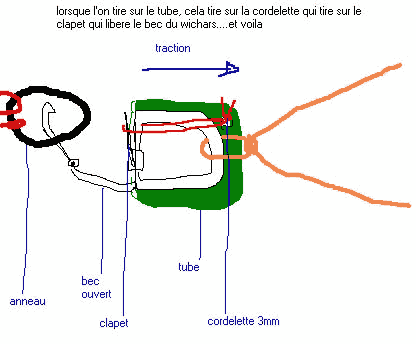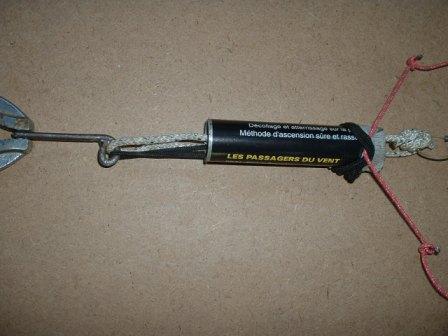http://www.wichard.com/fiche-A|WICHARD|2673-0202040301000000-ME.html

Click the zoom button.
There's a hole drilled through the body where you see the lanyard descending into it - narrow at the bottom, enlarged at the top.
---
2016/04/06 13:20:00 UTC
See Quest Air abortion at bottom of post.
---
You feed the lanyard down through it, tie an Overhand Knot as a stop, and draw it back into the body and seat it. You can see this easily if you've got a spinnaker shackle nearby.
By "unboosted" I mean you're just pulling straight back (down - in that photo) on the latch with no mechanical advantage - the way it was with the original Lookout "Release". (Zack can tell you all about those.)?
With the factory installed lanyard you're boosting it with a two to one mechanical advantage - ignoring friction and assuming you're pulling straight back.
With the way I had it rigged for my glider:
http://www.flickr.com/photos/aerotowrelease/8305428629/

you're also boosting it about two to one using the pulley system - not quite actually because, although the friction is pretty low, you're not pulling straight back.
With a brake lever, à la Wallaby, you're - in theory anyway - getting a about a four to one boost. (I once did a crude test and found that when you when you squeezed the lever about four (call it) millimeters you pulled in about one millimeter of cable.
BUT...
The thing's junk 'cause:
- There's friction and slop in the cable.
- There's a limit to how much you can squeeze the lever before it bottoms out on the tubing to which it's velcroed and if your adjustment is off one way it won't stay closed (which was the catalyst in the Rob Richardson fatality) and if it's off on the other you're going to have to figure out some other way of getting off tow.
- It's a draggy piece of crap and you'll be lucky to get one on a basetube and have it work.
Then the goons on the Quest Perfection Squad totally butchered the spinnaker shackle's inherent mechanical advantage by drilling and reconfiguring it such that the load pulled out on the gate rather than forward on the pivot point. (And I thought what Wallaby had already done to it was an atrocity.)
Not if it's a cable lanyard assembly with a lever on the other end - but it's still a crappy way to do things.If it is, some French pilots are using Wichard at the apex of the one point bridle AND UNBOOSTED
Assuming no or ignoring a brake lever - yes.Am I right ?
I don't. The whole notion is certifiably insane. I was just using it to compare the arithmetic.How do you consider the use of a Wichard with a 1 point bridle...
I used to and would again (if I had to) fly a spinnaker shackle. They're acceptably reliable enough IF they're rigged properly and the weak link loop is the right size (as in my photo above)....as you pointed the fact that wl on this release shouldn't be used, and your bridlelink is thin too.. ?
THIN isn't the problem - the size of the loop is. Too small and you pull a Robin, too large and you pull a Lauren.
Robin Strid's configuration was lunatic. He wasn't using a bridle and directly engaged a weak link on the end of the towline. The people who permitted that were ALL assholes. Saw competitors doing the SAME IDIOT THING at the Ridgely East Coast Championships no more than a year and a half later. If anything happens (and we know it DOES all the time) you can't get to it and you don't have a backup release (and I DO mean BACKUP in this connotation).
http://ozreport.com/9.042
No to the Spinnaker release
Bullshit.Davis Straub - 2005/02/21
Robin's spinnaker shackle was hooked directly to the tow line. I'm thinking that in this case the weaklink twisted at the end of the tow line (woven spectra, by the way, with Bobby Bailey at the other end on a Moyes-Bailey Dragonfly), and that caused the weaklink to bind around the leg of the spinnaker release.
- Davis? Thinking? Right.
- There's NO FREAKIN' WAY that towline developed enough twist while it was trailing during landing to wind that weak link closed on the spinnaker shackle gate.
My guess is that he cut the string too short for the number of loops he wanted and tried to make it work.
The risk involved with the gate can be managed. (But with enough monkeys and enough typewriters...)
What most bothers me about the spinnaker shackle is that it chews up the weak link each time you release under any tension. And I'm never letting it do that to one of my Bridle Links - they're too hard to make to allow anyone to abuse them that way.
http://groups.yahoo.com/group/TUGS/No one else knows 2 point AT (pilot+glider)
Everyone here learnt with 1 point (pilot only)
Mark Knight - 2011/02/10 02:06:57 UTC
Tempe
With the increase in Gasoline and other such nessesities to tugging. Is anyone thinking about raising tug rates? We have been charging 20.00 to 2000 feet for a long time and wondered what the going rates are around the USA. I would be interested in what everyone is charging for: Solo pilots. Tandem Pilots and Student/Tandem flights. Thanks
Eric Thorstenson - 2011/02/10 11:46:59 UTC
Wannabe Ranch Crew
Morton, Washington
Hey Mark and group,
We charge $10 per 1000' and of course no one is getting rich doing this, however we have a hell of a lot of fun!
We have no plans to increase our rates for tows.
What I am more concerned about is USHGA's new requirement for the aerotow rating and having to do two tandems to show proficiency.
Not sure about everyone outside of the large flight parks but this has a HUGE impact on us smaller tow parks and what it will cost us to get people a rating. We have a hard time as it is and now this....not long after the private pilot issue. What's next?
Tad Eareckson - 2011/02/10 17:14:22 UTC
Back in the Eighties we learned to fly on hills, put three-ring releases on our shoulders, hooked up behind Cosmos trikes, ran like hell, stuffed the bar for all we were worth, and figured it out on the way up. Wasn't the greatest way to do the job but it worked OK and I don't recall any necks getting broken as a consequence.
The big flight parks are gonna fight to the death against equipment standards which ground the kinda crap that got Shane Smith killed a couple of weeks ago but they don't seem to have any problem whatsoever encouraging bullshit regulations to help them gouge student pilots a little more.
Screw you again, Tracy.Tracy Tillman - 2011/02/10 20:08:32 UTC
Hey Tad. It's a big country, there must be a bunch of small not-for-profit sailplane clubs that teach aerotowing who can't afford a two-place glider. It would seem that you are saying that, whether in hang gliding or sailplanes, all the clubs and schools that have two-place gliders use them just so they can gouge students rather than trying to provide good aerotow training.
You can really prove the bullshit part if you can share with us the curriculum or even the urls of the sailplane clubs in your area that teach students or experienced airplane pilots to aerotow sailplanes using only solo flights.
Anybody who is truly a good pilot, in any form of aviation, knows that the knowledge, skills, and judgement you have in your head, learned from thorough instruction from a good instructor with a good curriculum, are the best pieces of equipment you can fly with. Good equipment is important, the best equipment is a well-trained brain. The ironic thing about flight training is that it is the student who avoids getting thorough instruction because they are paranoid about getting gouged is actually self-gouging a chunk of knowledge they should have out of their own brain.
At our club, the minimum cost for an experienced hang glider pilot to learn and show they have the aerotowing skills needed get an aerotow rating per the regs, with two tandems to 2500 feet ($90 each) and three solo flights to 2500 feet ($20 each) is $180 + $60 = $240. That's about the cost of a hang gliding helmet. The bullshit part is saying that cost, relative to the cost of five solo-only flights, is too expensive.
---
http://ozreport.com/forum/files/20160321_232034_101.jpg









